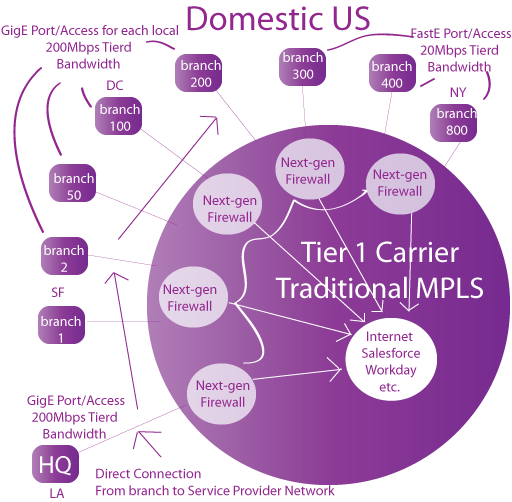Software-Defined Networking is disrupting many different technology segments, from the data center to switching/routing, WAN, and so on. In some areas there is no debate about the disruption, as in the case of how it will impact Cisco’s networking business. In other areas the value proposition is somewhat fuzzy. Let’s look deeper into one of these areas – Cloud-based SDN WAN vs. Traditional MPLS. Some companies like Viptela and Glue Networks discuss the benefits in terms of automation, orchestration, security, central management, lower cost, etc.
Jim Duffy from Networkworld stated that “Configuring, maintaining and changing WAN infrastructure can be a nightmare given the distributed nature of the beast and all its remote touch points, but emerging SDN tools promise to make these operations more efficient”. Many other notable experts present the same point of view, in that SDN in the WAN brings about a whole new level of automation and orchestration. In addition, there is better provisioning of video, wireless, firewalls, VLANs, and so on. Those arguments make a lot of sense, and they will definitely cause disruption in Cloud-based SDN WAN market at some point of time, but anytime soon? Maybe not. Now lets look at it from a Carrier point of view (Carrier = AT&T, Verizon, CenturyLink, Level 3, Windstream, XO…). The Traditional MPLS service must be given more credit than its getting now. It has a lot of benefits, and the value added services built on top of MPLS has increased over the last three years. In fact, lets summarize the benefits of Traditional MPLS.
Traditional MPLS benefits over SDN WAN
- Carrier MPLS is plug-and-play. Customer can buy MPLS for hundreds of locations, and Carrier ships configured routers that are plug-and-play ready
- One Carrier circuit can support MPLS, Internet and SIP
- Domestic MPLS takes 45-60 days to install, not months and months
- Carriers provide next-gen firewall (L3/4/7) in their network cloud via a firewall port, thus hundreds of locations can be turned up in a snappy
- Carrier sets up firewall policies, manages it and monitors the entire network
- Traditional MPLS is inexpensive nowadays
- SDN WAN customers must pay for local loop (unless on-net) and Internet port even if they decide against MPLS
- MPLS port pricing is practically the same as Internet port pricing
- GigE connectivity (loop / port) pricing has dropped dramatically in the last two years and can be had for a few thousands/month (single digits)
- Carriers offer firewall ports in the cloud so customers don’t have to buy a firewall for each location
- MPLS supports many transport types including Ethernet
- Conclusion: customer can completely outsource MPLS, router and firewall functionality to Carriers for a low monthly fee per location


